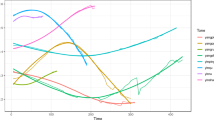Abstract
The goal of this paper is twofold. First, it discusses the tonal systems of several Chinese languages within the framework of the Theory of the Contrastive Hierarchy (Dresher et al. Toronto Working Papers in Linguistics 13:3–27, 1994; Dresher Talk Presented at Meeting of the Canadian Linguistics Association, University of Ottawa, 1998, Toronto Working Papers in Linguistics 20:47–62, 2003a, Asymmetry in grammar: Morphology, phonology, acquisition. Amsterdam, Netherlands: Benjamins, Vol. 2, pp. 239–257, 2003b). In particular, this paper demonstrates that disparities between phonetic characteristics of tones and their phonological activity can be understood as a kind of underspecification that the Contrastive Hierarchy affords. The second goal of this paper is to propose an analysis in which contour tones in Chinese languages generally are represented as unitary entities rather than as a concatenation of level tones (Tone Clusters). This contrasts with the tonal systems found in African languages, in which contour tones are demonstrably composed of level tones. Thus, this paper argues for the existence of two types of contour tones in natural language: unitary contour tones and Tone Clusters.
Similar content being viewed by others
References
Bao, Z. (1990). On the nature of tone. Dissertation, MIT.
Bao Z. (1999). The structure of tone. New York, Oxford University Press
Bauer R., Benedict P. (1997). Modern Cantonese phonology: Trends in linguistics, studies and Monographs 102. Berlin, Mouton de Gruyter
Bauer R., Cheung K.-H., Cheung P.-M. (2003). Variation and merger of the rising tones in Hong Kong Cantonese. Language Variation and Change 15, 211–225
Chao Y.-R. (1930). A system of tone letters. Le mâitre phonetique 45, 24–47
Chen M. (2000). Tone sandhi. Cambridge, Cambridge University Press
Cheng R.L. (1973a). Some notes on tone sandhi in Taiwanese. Linguistics 100, 5–25
Cheng T. (1973b). The phonology of Taishan. Journal of Chinese Linguistics 1, 256–322
Clements N., Hume E. (1995). The internal organization of speech sounds. In: Goldsmith J. (eds) The handbook of contemporary phonlogical theory. Cambridge, Blackwell, pp. 245-306
Dresher, B. E. (1998). On contrast and redundancy. Talk presented at Annual Meeting of the Canadian Linguistic Association, University of Ottawa.
Dresher B.E. (2003a). The contrastive hierarchy in phonology. Toronto Working Papers in Linguistics 20, 47–62
Dresher B.E. (2003b). Contrast and asymmetries in inventories. In: DiSciullo A.-M. (eds) Asymmetry in grammar: Morphology, phonology, acquisition Vol 2. Amsterdam, Netherlands, Benjamins, pp. 239-257
Dresher B.E., Piggott G., Rice K. (1994). Contrast in phonology: Overview. Toronto Working Papers in Linguistics 13, 3–27
Dresher B.E., Zhang X. (2005). Contrast and phonological activity in Manchu vowel systems. Canadian Journal of Linguistics 50, 45–82
Duanmu, S. (1990). A formal study of syllable, tone, stress and domain in Chinese languages. Dissertation, MIT.
Duanmu S. (1994). Against contour tone units. Linguistic Inquiry 25, 555–608
Egerod S. (1956). The Lungtu dialect. Copenhagen, Ejnar Munksgaard, Ltd
Goldsmith, J. (1976). Autosegmental phonology. Dissertation, MIT.
Hashimoto O.-K.Y. (1973). The Hakka dialect: A linguistic study of its phonology, syntax and lexicon. Cambridge, Cambridge University Press
He W. (1989). Huojia Fangyan Yanjiu [Studies in Huojia dialect]. Beijing, Shangwu Yingshuguan
Herbert R. (1975). Reanalyzing prenasalized consonants. Studies in African Linguistics 6, 105–123
Herbert R. (1986). Language universals, markedness theory, and natural phonetic processes. Berlin, Mouton de Gruyter
Him K.T. (1980). Semantic-tonal processes in Cantonese, Taishanese, Bobai, and Siamese. Journal of Chinese Linguistics 8, 205–240
Kao D. (1971). Structure of the syllable in Cantonese. The Hague, Mouton
Killingley S.-Y. (1985). A new look at Cantonese tones: Five or six?. Newcastle upon Tyne, Siew Yue Killingley
Leben, W. (1973). Suprasegmental phonology. Dissertation, MIT. Distributed by Indiana University Linguistics Club.
Leben W. (1978). The representation of tone. In: Fromkin V. (eds) Tone: A linguistic survey. New York, NY, Academic Press, pp. 177-219
Lombardi L. (1990). The nonlinear organization of the affricate. Natural Language & Linguistic Theory 8, 375–425
Maddieson I. (1978). Universals of tone. In: Greenberg J. (eds) Universals of Human Language. Stanford, CA, Stanford University Press, pp. 335-366
Matthews S., Yip V. (1994). Cantonese: A Comprehensive Grammar. London, Routledge
Mielke, J. (2004). The emergence of distinctive features. Dissertation, Ohio State University.
Mortensen, D. (2002). Semper Infidelis: Theoretical Dimensions of Tone Sandhi Chains in Jingpho and A-Hmao. Retrieved from http://socrates.berkeley.edu/edmort_semper_infidelis.pdf.
Pham H. (2003). Vietnamese tone: A new analysis. New York, Routledge
Phoon, M.-K. (1976). A synchronic phonology of modern Cantonese dialect. Institute of Humanities and Social Science, College of Graduate Studies: Nanyang University Occasional Paper Series, No. 39.
Pike K. (1948). Tone languages. Ann Arbor, University of Michigan Press
Sagey, E. (1986). The representation of features and relations in nonlinear phonology. Dissertation, MIT.
Steriade, D. (1989). Africates are stops. Paper presented at Conference on Features and Underspecification, MIT, October 1989.
Steriade D. (1993). Closure, release, and nasal contours. In: Huffman M., Krakow R. (eds) Phonetics and phonology. Nasals, nasalization and the velum (Vol. 5). San Diego, CA, Academic Press, pp. 401-470
Wan I.-P., Jaeger J. (1998). Speech errors and the represeantation of tone in Mandarin Chinese. Phonology 15, 417–461
Wang W. (1967). Phonological features of tone. International Journal of American Linguistics 33, 93–105
Yip, M. (1980). The tonal phonology of Chinese. Dissertation, MIT.
Yip M. (1989). Contour tones. Phonology 6, 149–174
Yip M. (1995). Tone in east Asian languages. In: Goldsmith J. (eds) The handbook of phonological theory. Cambridge, MA, Blackwell Publishing, pp. 476-494
Yip M. (2001). Tonal features, tonal inventories and phonetic targets. University College London Working Papers in Linguistics 13, 161–188
Zhang J. (2002). The effects of duration and sonority on contour tone distribution—A typological survey and formal analysis. New York City, Routledge
Author information
Authors and Affiliations
Corresponding author
Rights and permissions
About this article
Cite this article
Barrie, M. Contour tones and contrast in Chinese languages. J East Asian Linguist 16, 337–362 (2007). https://doi.org/10.1007/s10831-007-9017-1
Received:
Revised:
Accepted:
Published:
Issue Date:
DOI: https://doi.org/10.1007/s10831-007-9017-1




